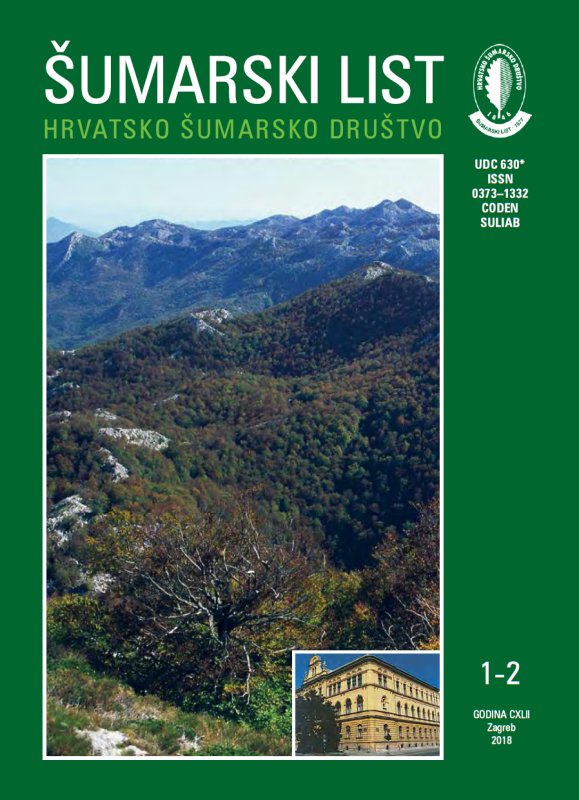
broj: 1-2/2018
pdf (4,94 MB) |
|
||||||||||||||
| RIJEČ UREDNIŠTVA | ||
| UREDNIŠTVO | ||
| IS THE FOREST ACT BINDING FOR ALL FOREST OWNERS? pdf HR EN | 5 | |
| IZVORNI ZNANSTVENI ČLANCI | ||
| Igor ANIĆ, Stjepan MIKAC, Mladen OGNJENOVIĆ | UDK 630* 568 + 815 (001) https://doi.org/10.31298/sl.142.1-2.1 | |
| SELECTION OF TREE SPECIES FOR THE SUBSTITUTION OF POPLAR PLANTATIONS ALONG THE RIVER DRAVA NEAR OSIJEK pdf HR EN | 7 | |
| Igor POLJAK, Marilena IDŽOJTIĆ, Irena ŠAPIĆ, Patrik KORIJAN, Joso VUKELIĆ | UDK 630* 181.8 + 164 (001) https://doi.org/10.31298/sl.142.1-2.2 | |
| DIVERSITY AND STRUCTURE OF CROATIAN CONTINENTAL AND ALPINE-DINARIC POPULATIONS OF GREY ALDER (Alnus incana /L./ Moench subsp. incana): ISOLATION BY DISTANCE AND ENVIRONMENT EXPLAINS PHENOTYPIC DIVERGENCE pdf HR EN | 19 | |
| Martin BOBINAC, Siniša ANDRAŠEV, Andrijana BAUER-ŽIVKOVIĆ, Nikola ŠUŠIĆ | UDK 630*242 (001) https://doi.org/10.31298/sl.142.1-2.3 | |
| EFFECTS OF HEAVY THINNINGS ON THE INCREMENT AND STABILITY OF A NORWAY SPRUCE STAND AND ITS TREES BETWEEN THE AGES OF 32 AND 50 pdf HR EN | 33 | |
| Bratislav MATOVIĆ, Miloš KOPRIVICA, Bratislav KISIN, Dejan STOJANOVIĆ, Igor KNEGINJIĆ, Stefan STJEPANOVIĆ | UDK* 228 + 653 (001) https://doi.org/10.31298/sl.142.1-2.4 | |
| COMPARISON OF STAND STRUCTURE IN MANAGED AND VIRGIN EUROPEAN BEECH FORESTS IN SERBIA pdf HR EN | 47 | |
| PRETHODNO PRIOPĆENJE | ||
| Milan PERNEK | UDK 630* 453 https://doi.org/10.31298/sl.142.1-2.5 | |
| NEW CALCULATION OF CRITICAL NUMBER OF GYPSY MOTH (Lymantria dispar L.) EGG MASSES FOR BETTER POPULATION DENSITY PROGNOSIS pdf HR EN | 59 | |
| Summary Gypsy moth, Lymantria dispar was the dominat oak forest pest in Croatia untill 1960s. After this period population particularly in the continental part decreased with cyclical outbreaks every 10-11 years. Last two outbreaks occurred in 2003-2005, and in 2013-2014. In this study a new calculation of critical number of gypsy moth egg masses has been presented in order to estimate the risk of defoliation which is crucial for the decision about application of necessary control measures. The calculation shows critical numbers as number of egg mases per ha which differ from the previous calculations based on number of trees which carry at least 1 egg mass shown in percentages. Hitherto 5 Classes were known out of which the 5th was critical. This Class presented 50% of trees which carry at least 1 egg mas and it was assessed as critical. In such calculation the age of the trees was not taken in account although the amount of leaves in the canopy strongly depend on that. Furthermore the number of eggs in the egg masses was also ignored. New calculation is based on numbers of caterpillars which have the potential to defoliate an oak tree of different ages, obtained from literature. The average number of eggs in one egg mass was calculated out of 50 sampled and analysed egg masses. This data together with the normal distribution of oak trees per ha build the basis for the formula. Based on that 3 Categories were formulated which show the potential for defoliation and help to make the decision for applying control measures: Category I – control measures needed; Category II – control measures needed only if there is a special reason; Category III – no control measures needed. Critical numbers of old and new calculation have been compared in years of outbreaks. Results between new and old calculation show 25% difference which directly means 25% less area that needs treatment with insecticides. Although the new method has advantages there is still some limitation in the calculation considering that important variables are ignored. The real number of trees per ha and the actual number of intact caterpillars should be used for more accurate calculation and further reduction of forest area that needs protection. Future research should concentrate on precise calculations of leaf weight consumed by average caterpillar in the relationship to crown volume both for oak and common beech. These values in combination with the number of leaves in the particular forest would make the decisions on use of insecticides more accurate which would bring additional substantial financial savings. Key words: population dynamics; pest control; pedunculate oak; Quercus robur | ||
| Luka RUMORA, Mario Miler, Damir MEDAK | UDK 630* 587 https://doi.org/10.31298/sl.142.1-2.6 | |
| IMAGE FUSION INFLUENCE ON FOREST AREA CHANGE USING UNSUPERVISED CLASSIFICATION pdf HR EN | 67 | |
| PREGLEDNI ČLANCI | ||
| Carlos G. ROSSA, Paulo M. FERNANDES | UDK 630* 148.2 + 111.8 https://doi.org/10.31298/sl.142.1-2.7 | |
| ON THE FIRE-SPREAD RATE INFLUENCE OF SOME FUEL BED PARAMETERS DERIVED FROM ROTHERMEL’S MODEL THERMAL ENERGY BALANCE pdf HR EN | 77 | |


